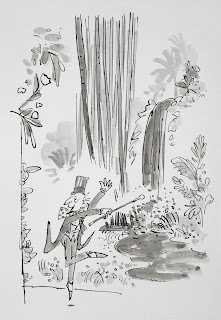This Christmas which picture books did you give, share or discover? I thought I would share some Christmas presents and some books that are favourites.
 Little Ruaridh is 2 years old and he just loves tractors and diggers.
Little Ruaridh is 2 years old and he just loves tractors and diggers.For Christmas this year he got his own copy of a book he had enjoyed when they borrowed it from their local library.

It was Goodnight Tractor by Michelle Robinson and Nick East. He also got a copy of Goodnight Digger. These are part of a series of books all very similar in style with gentle rhyme.
Goodnight Tractor and the other books in this series work in the same way that parents have often encouraged children to settle down to sleep, by saying goodnight to their toys before going to bed.
'....goodnight pig and goodnight sheep... goodnight tractor time to sleep.'

Ruaridh loves them and it does settle him down to sleep. He also loves Goodnight Princess, as does his sister, Abigail.
Abigail is 4 and loves her books. One of her favourites this year has been Julia Donaldson's Jack and the Flumflum Tree, illustrated by David Roberts

Jack heads off in search of the fruit of the Flumflum tree to cure his Moozles and encounters all sorts of problems but he has his granny's patchwork sack filled with a strange assortment of things that prove to be just what he needs in every situation!

Poppy is 3 and she also loves her stories.
Jack and the Flumflum Tree has recently been on her reading list as she recovered from her own Moozles!

Another favourite is Giraffes Can't Dance by Giles Andreae and Guy Parker-Rees.
 As you can see in the picture,she also loves Hamish McHaggis and likes to keep him close by at night because she knows he keeps her safe from bad dreams and her little brother Benedict has his own little Hamish, too!
As you can see in the picture,she also loves Hamish McHaggis and likes to keep him close by at night because she knows he keeps her safe from bad dreams and her little brother Benedict has his own little Hamish, too! 
 Baby Benedict is 7 months this Christmas and he is just getting the hang of books. He has inherited a lot of his big sister's books but his Christmas presents included Usborne's Baby's Very First Touchy-feely Book. One of the many great books for tinies with textures to touch, and bright colours and images.
Baby Benedict is 7 months this Christmas and he is just getting the hang of books. He has inherited a lot of his big sister's books but his Christmas presents included Usborne's Baby's Very First Touchy-feely Book. One of the many great books for tinies with textures to touch, and bright colours and images.So this Christmas which picture books did you give, share or discover?
Linda Strachan is the award winning author of over 60 books for all ages, from picture books to YA novels, and writing handbook Writing For Children
Website www.lindastrachan.com
Blog BOOKWORDS



+David+Roberts.jpg)














